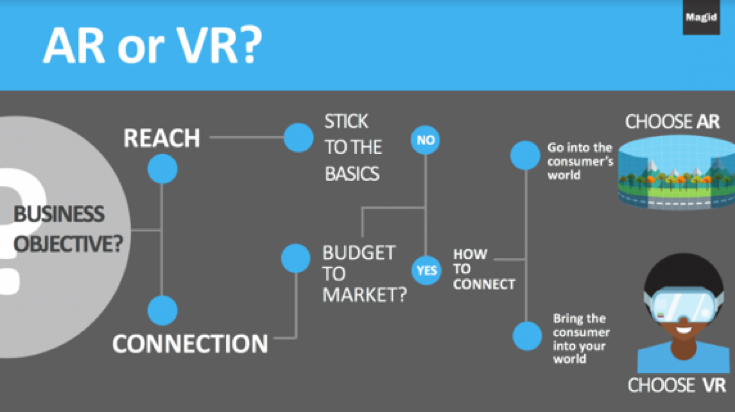A Decision Tree for Immersive Tech in Your Marketing Efforts
This byline by Magid’s Debby Ruth was originally published on Dealerscope.
Brands have an increasing number of digital options to market to consumers—some of the more alluring ones fall into the category of immersive tech (i.e. augmented, virtual and mixed reality). Because each new technology presents its own unique learning curve and complexity, we’ve created a simple framework to help marketers decide if immersive tech should be in the consideration set and, if so, which type should be deployed.
This decision tree is based on where immersive technology exists in its evolution today and is grounded in research we conducted as part of the Magid VR/AR Insights Consortium. (If you are reading this in 2022, stop here—the world has certainly changed.) This research was focused on entertainment, but the overarching insights can be applied more widely. Magid conducted six 2-hour focus groups with consumers familiar with immersive technology—3 in NYC and 3 in L.A. —to explore the impact of ancillary content (VR, AR, MR, and generally) on corresponding entertainment content/brands.

As with any marketing plan, one of the first questions is, “what business objective are you trying to accomplish?” In other words, the strategy must start with the goal of your marketing initiative.
Everyone wants both to expand the reach of their product or service anddeepen the connection they have with their consumers, but when it comes to deciding whether or not to use immersive tech, you have to choose which is more important.
If expanding reach wins, AR/VR is likely not worth the investment of your time and resources. In addition to limitations like having access to the necessary technology, “Discoverability” and “Shareability” remain serious challenges for immersive tech. VR/AR experiences are simply hard for consumers to find and share. Additionally, in the case of VR, the amount of energy required for set-up can also be a barrier.
If your objective is to establish a deep connection with your customers, immersive tech offers unprecedented opportunities and could be an attractive option. Immersive technologies offer the opportunity to provide experiences—experiential marketing beyond events.
Following the deep connection pathway in the decision tree, the next question to ask yourself is, do you have budget or the channels to market the marketing? Making consumers aware of new AR/VR content is no small feat, especially now that the novelty has passed and press coverage of innovative marketing using immersive tech are not guaranteed. That makes building awareness of experiences up to you and your brand. If you don’t have the budget or natural channels to market the immersive ancillary content, then maybe it’s not the best investment for now.
If you do have the budget or natural channels to build awareness of your immersive experiences, the final question you need to ask is, “how do you want your brand to connect with your consumer?” VR is the way to their hearts, while AR is the way to their habits. Consumers report feeling a more emotional connection with VR content and prefer AR for useful/additive learning.
With VR, you can bring the consumer into your world and experience, evoke feelings and delight them with an immersive journey that generates a sense of presence.
With AR, you bring your brand into the life and world of your consumer. You become a part of their surroundings and can bring everything from fun and entertaining engagement with characters complete with selfies, to informative and useful product interactions. Consumers like to feel as if they have been rewarded or have benefited in some way using AR.
In both cases, make sure you leverage your investment by making it very easy for your customers to share their experiences with their friends and followers on social media.
As immersive technologies evolve and their use becomes more natural and mainstream, best practices will certainly evolve, but for now, this framework will take you back to the basics when deciding if and how to engage with consumers using immersive technology.

